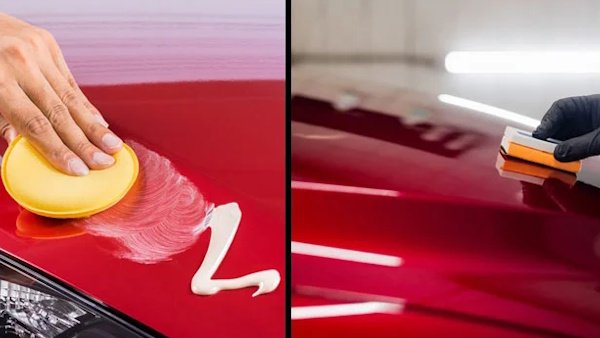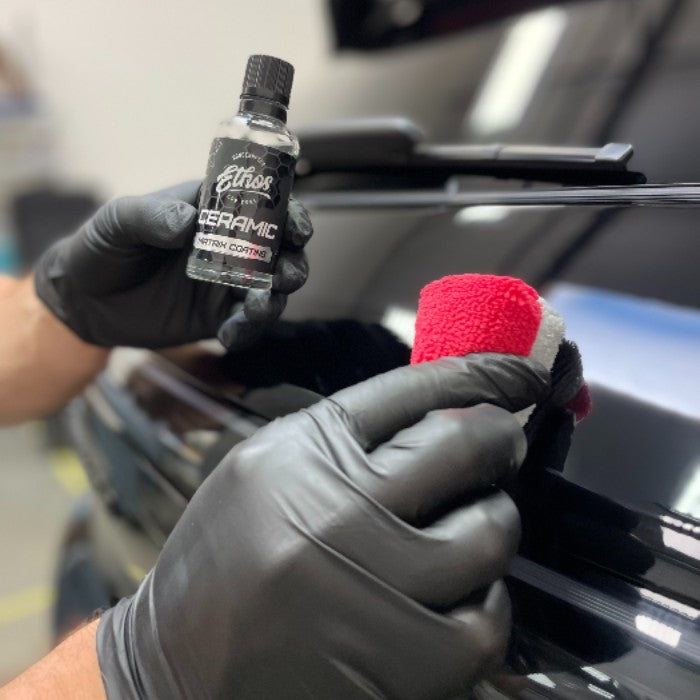Why families prefer Ceramic Coating Newark for low maintenance
Wiki Article
Exploring the Scientific Research Behind Car Ceramic Coating and Its Safety Qualities
The science of car ceramic coating presents a remarkable research study in advanced automotive defense. Composed largely of silicon dioxide and polymers, these coatings form a robust bond with automobile paint. This communication improves sturdiness versus environmental risks while supplying hydrophobic advantages. However, the complexities of exactly how these finishes job and their long-lasting benefits stay much less comprehended. Unpacking these details reveals why ceramic coatings are coming to be a preferred choice for car careWhat Is Ceramic Coating?
Ceramic coating is a fluid polymer that chemically bonds to the surface area of a car's paint. This innovative safety layer improves durability and offers premium resistance to environmental aspects. Unlike traditional wax or sealants, which offer short-term protection, ceramic coatings develop a durable guard that can hold up against harsh problems such as UV rays, acidic pollutants, and extreme climate. When used appropriately, the coating creates a hydrophobic surface, triggering water to grain and slide off, which assists in maintaining the lorry's cleanliness. Additionally, it uses improved gloss and deepness to the paint, making the automobile show up even more sleek and vibrant. The application process normally entails thorough surface prep work, consisting of cleansing and polishing, to guarantee peak bonding. Because of this, ceramic layers are ending up being progressively popular among car enthusiasts and those looking for to shield their investments, guaranteeing to keep the lorry's aesthetic charm while decreasing the frequency of maintenance.The Composition of Ceramic Coatings
The elaborate solution of ceramic finishings mainly includes silicon dioxide (SiO2), which is originated from all-natural sources like quartz and sand. This crucial element supplies the structure for the coating's sturdiness and safety qualities. In addition to SiO2, ceramic layers commonly consist of numerous polymers and additives that improve attachment, flexibility, and resistance to environmental aspects. These compounds function synergistically to develop a durable barrier versus impurities such as dirt, chemicals, and UV rays.Furthermore, some formulations integrate titanium dioxide (TiO2) or various other nanomaterials, which can boost the coating's hydrophobic properties, leading to enhanced water repellency. The exact make-up can vary significantly among producers, impacting efficiency and long life. Inevitably, the mix of these components finishes in a protective layer that not just enhances the visual charm of automobiles but also serves to prolong their lifespan by shielding the surface area from potential damages.How Ceramic Coatings Work
Recognizing how ceramic finishes function includes discovering their chemical structure, which adds to their safety top qualities. The application procedure is important for accomplishing optimal results, while longevity and longevity elements establish the coating's performance in time. Together, these components highlight the advantages and efficiency of ceramic layers for car protection.Chemical Make-up Explained
While numerous car proprietors seek long-lasting defense for their automobiles, the chemical composition of ceramic layers plays an essential duty in their efficiency. These coverings primarily contain silicon dioxide (SiO2), which is originated from natural minerals. This substance forms a solid bond with the car's paint, creating a long lasting, safety layer. In addition, many ceramic finishings contain titanium dioxide (TiO2), boosting their hydrophobic residential properties and resistance to UV rays. The existence of polysiloxanes can additionally improve flexibility and sturdiness. With each other, these aspects contribute to the coating's capacity to drive away water, dust, and pollutants, while likewise offering a high-gloss finish. Recognizing this chemical structure helps car owners value the durable defense used by ceramic coverings.Application Process Introduction
Using ceramic coatings entails a precise procedure that guarantees optimal bonding and defense for the automobile's surface area. At first, extensive cleaning and decontamination of the car's exterior are performed to remove dust, gunk, and previous waxes. This action validates that the surface is without pollutants that might prevent adhesion. Following this, the paint is frequently brightened to boost clearness and eliminate any type have a peek at these guys of flaws. As soon as prepared, the ceramic coating is applied in little sections using an applicator pad, enabling consistent coverage. The coating is then left to heal, creating a solid chemical bond with the surface. Correct treating times and problems are essential, as they confirm the coating attains its maximum effectiveness and protective qualities.Durability and Durability Aspects
Ceramic finishes are created to offer resilient security with their sophisticated chemical structure, which develops a robust obstacle versus environmental contaminants. The durability of these finishings is influenced by aspects such as the thickness of the application, the top quality of the item, and the problems under which the automobile is exposed. Top quality ceramic coatings can last a number of years, resisting scratches, UV rays, and chemical discolorations. Proper upkeep, including normal washing and periodic reapplication, can better improve long life. Furthermore, environmental variables like climate and direct exposure to toxins can impact the lifespan of the coating. In general, when used and kept appropriately, ceramic finishings offer remarkable durability, making them a prominent choice for car enthusiasts seeking to maintain their lorry's look.Hydrophobic Qualities and Water Repellency
Hydrophobic homes are a trademark of high quality car ceramic layers, considerably boosting the car's surface area efficiency. These coatings produce a molecular bond with the car's paint, leading to a surface area that repels water successfully. When water comes into contact with a ceramic-coated surface area, it beads up and rolls off, lessening the quantity of liquid that stays on the paint. This habits not only adds to an aesthetically pleasing appearance but also lowers the buildup of contaminants such as dust, crud, and roadway salts.The enhanced water repellency causes less complicated cleaning and upkeep, as much less initiative is called for to remove unwanted compounds. Furthermore, the hydrophobic nature of ceramic coatings helps in stopping water areas, which can mar the surface of uncoated surface areas. Overall, the incorporation of hydrophobic residential or commercial properties in ceramic coatings plays an essential duty in maintaining the vehicle's pristine look while simplifying upkeep.Defense Versus Scratches and UV Damages
Car ceramic finishes provide significant defense against scrapes and UV damage. The scrape resistance mechanism develops a durable layer that takes in influences, while the UV protecting benefits help keep the lorry's paint stability gradually. Together, these attributes add to a longer-lasting and go now aesthetically attractive finish.Scratch Resistance Device
Using advanced technology, ceramic layers give a robust shield versus scratches and UV damages, boosting the longevity and appearance of lorry surface areas. The scrape resistance device of these finishes is attributed to their distinct molecular structure, which creates a long lasting bond with the vehicle's paint. This bond creates a hard, protective layer that can absorb impacts and withstand abrasions. Furthermore, the smooth surface of the coating decreases rubbing, making it challenging for impurities to stick and trigger scratches. The chemical make-up of ceramic finishes typically includes nanoparticles that strengthen the protective layer, further improving its durability. Lorries treated with ceramic coverings display noticeably enhanced scratch resistance contrasted to conventional wax or sealers, making certain an immaculate surface over time.UV Shielding Conveniences
The protective qualities of ceramic layers extend past scratch resistance to consist of considerable UV shielding advantages. These finishings develop a durable barrier that mirrors dangerous ultraviolet rays, protecting the lorry's paint and underlying materials. Prolonged exposure to UV radiation can lead to fading, oxidation, and degeneration of the paint finish. By including ceramic finishings, lorry owners can efficiently mitigate these threats, preserving the visual appeal and stability of their vehicles. In addition, the UV blocking properties add to improved longevity, reducing the regularity of painting and maintenance. Eventually, the assimilation of ceramic coatings supplies a complete service for protecting lorries from the harmful results of sun direct exposure, making certain a continual, vivid look over time.The Long life and Upkeep of Ceramic Coatings

Regularly Asked Inquiries
Can Porcelain Coating Be Applied to Any Type of Automobile?
Ceramic coating can be used to different kinds of vehicles, including autos, vehicles, and bikes. Surface area prep work and compatibility with specific products are important for optimal adhesion and performance of the coating.Just How Much Does Ceramic Coating Normally Cost?
Ceramic coating typically costs between $500 and $2,000, depending upon elements such as car size, coating quality, and professional application. The financial investment can provide lasting security and enhance the vehicle's look with time.
Is Professional Application Required for Ideal Results?
The need of specialist application often relies on preferred outcomes. Experts normally guarantee appropriate surface area preparation and application techniques, resulting in optimal bonding and durability of the coating, which may be testing for unskilled individuals to attain.Can Porcelain Coatings Be Gotten Rid Of or Repaired?
Ceramic coverings can be removed or fixed, though the process might call for certain solvents or methods - Ceramic Coating Newark. Proper elimination is necessary to prevent damages to the underlying surface, stressing the relevance of expert assistance for ideal resultsJust How Does Ceramic Coating Contrast to Typical Wax?
The contrast between ceramic coating and typical wax exposes that navigate to this site ceramic coverings offer remarkable toughness, improved security versus environmental impurities, and longer-lasting shine, while wax needs extra frequent application and gives much less total resistance to damages.Report this wiki page